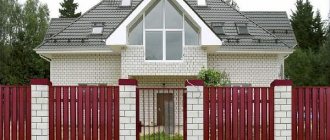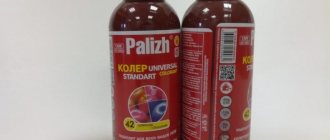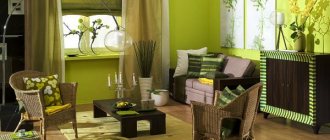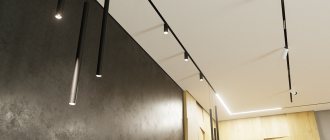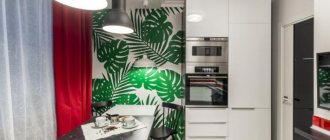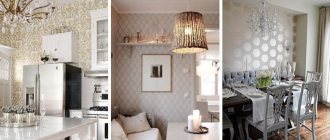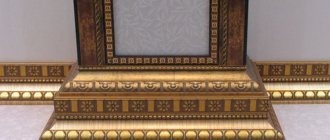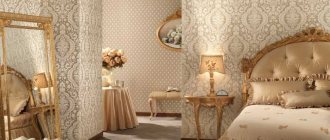Sometimes, when deciding what color of fence should be on a summer cottage or in a private house, a person spends quite a lot of time to choose the best option. The color of the fence can become a stumbling block if the owner has not thought about the principles of compatibility in advance. This happens if he purchased sharply contrasting paints for the roof, walls of the house and fences.
Unusual fencing
Modern building design sometimes contains conflicting instructions about what colors can or cannot be painted. But often only the owner of the land can choose the right color for the fence.
What determines the choice of fencing color?
Painting a fence near a house or in a country house is not so easy. Building design sometimes gives instructions that contradict the wishes of the residents themselves or the rules of territory design according to Feng Shui. The situation is complicated by the presence of a huge assortment of paints for wooden and metal structures, so without special knowledge you can get confused. To find the best color, before painting you should carefully study the factors influencing this choice:
- background of house elements - roof, walls, window frames, veranda and porch;
- home style;
- color schemes on the site, shades of additional buildings, structures, structures;
- amount of green space;
- colors of fences in neighboring areas.
Taking these factors into account, you need to decide on the main goal: whether the fence will blend into the landscape, get lost, be discreet, or, on the contrary, you want to highlight it, make it bright and unusual. For the first option, it is better to paint the gate and the fence itself in the same color scheme as the facades. You can also use a color close to the shade of the roof, which often serves as the base for the design of the entire area. The second design option involves an interesting contrasting combination of colors: for example, a chocolate fence for a turquoise or blue house.
General rules
There are no clear guidelines. Everyone has their own taste and preferences, but when a single ensemble is created, the area looks more well-groomed. Designers use the following guidelines as a basis: no matter what paints are used, the color of the roof should be darker and the walls lighter. It is better to paint the fence in the same color scheme as the roof or to match the façade finish. A technique is allowed when the fence is designed in exactly the same way as other elements of landscape design.
It is quite acceptable to paint the fence at the dacha beautifully, using two or three colors at once, but no more. It looks like a win-win option when you choose a combination of several shades of the same paint.
There are universal colors in the palette (black, gray, white, brown). They fit perfectly into any stylistic concept. They can also be used to create contrasts. With their help you can emphasize the beauty of greenery. Against the background of flowering plants, light openwork black metal forging and a white wooden picket fence will look impressive. This is a classic.
Experts, talking about how to beautifully paint a fence at the dacha, advise careful use of bright colors. They fit well into landscape design, but very quickly bother the eye, tire a person and then cause persistent irritation. Shades of beige, cream, and lemon are perceived much calmer.
When choosing a palette, it is important to take into account the architectural features of the house and the design of the site itself. If the walls of the building are covered with green paint, and then densely planted with greenery around the dacha, the house will lose its individuality and merge with the surrounding mass. Painting the fence green will provoke exactly the same effect. But in this situation such a technique will be justified. The fence will not be conspicuous, but all its functions will be preserved. The site will not be overloaded with massive structures, which is why the space inside will be light and airy.
When choosing what color to paint a fence, it is important to consider what load it will bear in combination with the surrounding landscape. If you cover the fences with light paint, it can highlight and clearly define the perimeter boundaries of the area. If the fence is painted to match the greenery, it will dissolve against its background and will be completely invisible.
Many people, thinking about what color to paint the fence at their dacha, forget to look around. Individuality is good, but sometimes you shouldn’t stand out from your neighbors’ plots. Often fences made in some flashy design demonstrate a lack of good taste. Therefore, in order not to make a mistake, it is better not to stand out too much on the outside. And inside the pallet, your imagination may not be limited by anything.
Fencing for the site: selection of material and shade
The color of the fence needs to be planned depending on the material of manufacture. Each of them has a number of advantages and disadvantages regarding operation and paintability.
Wooden fence
A wooden fence is a classic of the genre that will never become outdated. To make a picket fence, no special knowledge is required; it is easy to make with your own hands, embodying any idea. The easiest way is to buy ready-made sections of the required height and width that are already fastened with wooden planks. On sale there is a simple fence and a 3D picket fence with convex elements.
You can also make a wooden fence yourself from uncut or sanded boards, lining, bars, give them any shape and paint them in the desired color. Typically, connoisseurs of naturalness choose simple varnishing of wood so as not to cover its natural shade. In addition, the wood is covered with stain and then varnished: in this way, the cheapest species can be “transformed” into an elite one.
It is recommended to paint the wooden fence in accordance with the colors of the other elements. The color of aqua, green, and light green goes well with wood. White, beige and other light shades should not be used, or several coats will be required to cover the natural wood tone. The disadvantages of a wooden fence include rotting, short service life (up to 15 years), and the need for constant maintenance and painting. For greater reliability, you can combine wood with concrete and stone.
Fence made of corrugated sheets
Profiles, corrugated sheets, and profiled sheets are excellent materials for making fences, as well as sliding and drive-out gates. Such fences are increasingly being installed in summer cottages, because they are very durable, do not react to external factors, are durable, and protect from prying eyes and noise. Caring for the material is very simple: it is easy to repair and paint.
A fence made of corrugated sheets also has disadvantages. It is ugly on the inside, and on the outside it does not provide the opportunity to organize a unique, unusual design for the site. However, there are ways to solve this problem: a corrugated fence can be combined with brickwork, concrete pillars, and colored mesh. In addition, modern corrugated sheeting with a polymer or zinc coating can be either plain or imitate brick, masonry and even wood.
What shade to choose for a fence made of corrugated sheets? It looks best in these colors:
- brown;
- chocolate;
- blue;
- Ivory;
- green.
Against the background of white wall facades, a cherry-colored fence looks attractive, and a beige fence is suitable for the masonry of the house.
Metal profile fence
A fence made of metal profiles or European picket fences also has a long service life, greater reliability, and is more aesthetically pleasing. A Euro picket fence, for example, imitates a fence made of natural wood and is combined with brick posts. Lamellas made of galvanized steel do not fade, are very durable, and can be installed in a simple or staggered manner. For such a fence, light shades are usually chosen: blue, green, white, beige, light gray, although it all depends on a successful combination with the color of the roof and the house.
How to paint a metal fence
A stylish and beautiful metal fence has its own enemy - rust. The surest way to deal with it is one: the metal needs to be painted. Metal painting has its own specifics.
- Paints for metal must contain, in addition to coloring components, anti-corrosion and protective substances.
- Fences and other small forged products are painted with paints based on organic substances or rubber enamels.
- The traditional method of processing a metal rod includes cleaning it from dirt and rust, coating it with an anti-corrosion compound, and only after these procedures, applying paint.
- Modern primers successfully act as a rust remover, and universal paints allow you to paint over minor corrosion without prior priming.
- For forged products and rods, it is more convenient to use spray paints.
As for color, painting a metal fence has its own nuances.
Manufacturers offer a great variety of paint shades, but simply painting metal, especially forged metal, is not enough. Painting is very popular, in which a layer of another paint is applied to the main surface to give the effect of antiquity, slight deformation, aged bronze, copper, gold, silver. This artificial aging is called patination. The best effect is obtained with an initial base of graphite color. The paint to be used for patting is stirred, rubbed with a sponge on any auxiliary surface, and applied to individual areas of the product to be painted. A stylish antique item is ready. As we can see, choosing a color for various categories of fences is, although not an easy task, but interesting and important.
Color combination of fence and facade
The shade of the fence sets the general direction of the design of the site, because it is the fence that first meets a person when approaching the house. The classic rule for selecting the shade of a fence is: “dark top – light bottom.” This solution is considered traditional, so a dark-colored roof and fence in combination with a light facade are used by designers quite often. You can make all the main elements (facades, roof, fence) dark, while choosing the finishing (windows, doors, veranda, gates, drainage system) in light colors.
When designing a site, style plays an important role. So, for a country-style home, a fence made of natural-colored wood coated with stain (oak, walnut, cherry and others) is ideal. For a castle-style house, it is worth choosing fences made of natural stone and brick.
Creating an entrance
The fence gate should not be located opposite the doors. This is considered a bad sign in Feng Shui: the energy will “walk”, as if in a draft. How to login correctly:
- It’s also not a good idea to place the entrance to the area behind the building: it’s ideal to place it at an angle so that the gate can be seen from the entrance doors.
- The gate should be medium in size: an entrance that is too wide or narrow interferes with the movement of energy.
Article on the topic: How to make a bathhouse from a barn
The shape chosen is rainbow-like (round). Sharp corners in the teaching are considered too rough, while rounded ones soften the flow of energy to the site and into the house.
Bells or jingling coins are hung above the gate. This way the wind will bring wealth to the site. If the house is located near a road or highway, the front entrance is moved further away and fenced off with green spaces.
Which color is easier to care for?
Many people mistakenly believe that a gray fence or a black fence is ideal in terms of cleanliness: they hardly get dirty, and dirt is not visible on them. In reality this is not the case. On a dark fence, street dust is very noticeable, especially drops of dirt after rain, when they dry out. Dried streaks of water are noticeable on the metal surface, giving the fence an unaesthetic appearance. Of course, dirt will also be visible on a white or beige fence, even small spots.
The easiest to maintain is considered to be a green and brown fence in any shade of these colors. The dirt on it is less noticeable, but you still have to wash it periodically. Therefore, it is better to choose a material for the fence that is easily cleaned with a stream of water from a hose and does not deteriorate from regular washing.
Unusual rose for March 8th.
I have already gotten used to the fact that by February 14 and March 8, they order only roses from me in different interpretations.
But this time the order was really strange, unusual and interesting) We ordered THROWING roses O_o
Well.. — I thought — everyone has their own methods of conquering girls) It turned out that the customer is a member of the Federation of Professional Knife and Ax Throwing, which is in St. Petersburg) By the way, he is a very charismatic and pleasant person).
What fence color to choose according to Feng Shui
To ensure harmony and arrangement of the courtyard, it is worth painting all the main elements in accordance with Feng Shui recommendations. As for the fence, the Taoist practice of designing space advises starting with it, because it is the first barrier, protection from the outside world and negative energy.
Feng Shui believes that a fence attracts different types of energy forces, so the mood in the family, the number of conflicts, and harmony in the house will depend on its color. It is worth considering the main colors for fences to understand their impact on residents.
Black
You should not paint the fence black; it will provide the area with a gloomy, oppressive atmosphere. By constantly contemplating the fence, a person himself reduces the amount of positive Chi energy, while increasing the negative influence of bad Chi energy.
White
From a practical point of view, a white fence is also not a good option. Of course, it symbolizes purity and tenderness, but in relation to energy it represents vacuum and death. The abundance of white color leads to depletion of the energy forces of household members.
Blue
A blue fence slightly reduces a person’s strength and energy activity, as it brings an atmosphere of relaxation. You can use blue to paint a fence only if a person needs calmness, a reduction in the feeling of chaos, or too violent energy.
Violet
This color is a symbol of greatness and excellent mental abilities. It is great for painting hedges and increases the flow of positive Qi energy.
Green
Green is ideal for south-facing fences and also looks great on the inside of the fence. It gives harmony and tranquility to the entire area, and triggers a restorative function. Green will outline the area like a hedge and enhance the feeling of closeness to nature. Experts especially advise using it where there is a shortage of bushes and trees.
Yellow
Bright yellow color can cause aggressive behavior, irritability, anger, as it carries masculine Yang energy. But soft shades of yellow and golden tones will give cheerfulness and optimism; they are perfect for decorating a site.
Red
This color is the most powerful, according to Feng Shui. It must be used with great caution, since in significant quantities it carries aggression and anger. In muted, dusty tones, red is still suitable for painting a fence, unlike fiery, purple, and crimson colors. In addition, irritable people should not use any shade of red for the inside of the fence. You can combine red with green, because the latter will restore the strength of the residents and reduce the risk of discord in family relationships.
Brown
This color is the leader among those used for painting fences, because, from a design point of view, it is ideal. According to Feng Shui, it is also considered suitable for painting a fence, but only for those located on the east and southeast sides. In this case, brown will reflect wealth, abundance, good reputation and luck of the person.
Choosing the main shade for a fence on your own, taking into account a lot of data and influencing factors may seem difficult. And yet, this can be done, guided by useful information and your own preferences, then the site will only cause joy and a feeling of harmony!
Advice from psychologists
It has long been proven that the color palette greatly influences a person’s psycho-emotional state. She is able to change the mood, shape the microclimate in the family and even (according to the Feng Shui technique) change its well-being. Since all these factors are very important, you should not ignore them. From this point of view, each paint has its own advantages and disadvantages.
Bright red color - bright, catchy, memorable. In Feng Shui philosophy, it symbolizes growth and wealth. But practice shows that red fences greatly irritate neighbors. Quarrels often break out among residents with such fences. The choice of darker and dull shades (burgundy, for example) helps to smooth out this moment.
A varied palette of green (from olive to khaki) is associated with peace and tranquility. It blends in with the plants and helps the eye take a break from the bright shocks. The human brain reacts positively to this: the nerves calm down, the person rests. This choice has only one drawback: behind a green fence and dense greenery, the house will not be visible at all. Its architecture will hide from the eyes of passers-by.
A blue fence goes well with the color of natural wood and brickwork, with a gray palette of concrete. In Feng Shui, blue paint symbolizes streamlining. If you build a blue fence around your house, it will protect it from loss of luck. But you can’t make a roof in this color: prosperity will drain from the estate and bypass its inhabitants.
Brown color is financial stability. All shades of this palette look rustic and even very modest. But brown inspires confidence.
Black color and all shades of dark gray contribute to the formation of a gloomy atmosphere. Against their background, dust immediately becomes visible. Therefore, it is not the best choice for framing. Typically, such paints are used to create contrasts or a clear frame. It emphasizes the severity of the fence and gives it a finished appearance. Designers, answering the question of how to beautifully paint a fence with two colors, usually advise using soft contrasts of the darkest tones of light paints and black. It turns out very beautiful.
